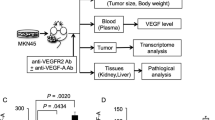Abstract
The efficacy of a phosphorothioate antisense oligonucleotide (ASO) for KDR/Flk-1 (KDR/Flk-1-ASO), an endothelial cell–specific vascular endothelial growth factor (VEGF) receptor, was investigated on the peritoneal dissemination and angiogenesis of a human gastric cancer cell line in nude mice. Green fluorescent protein (GFP)–transduced NUGC-4 (NUGC-4-GFP) human gastric cancer cells were implanted into the peritoneal cavity of nude mice. KDR/Flk-1-ASO, -SO, or phosphate-buffered saline was administrated from days 7 to 14, 200 μg/mouse, once a day. The mice were sacrificed on day 28. Disseminated peritoneal tumor nodules expressing GFP were visualized by fluorescence microscopy. KDR/Flk-1-ASO significantly decreased the extent of peritoneal dissemination of the tumors. The number of cells undergoing apoptosis was significantly increased in the KDR/Flk-1-ASO–treated tumors. Microvessel density was significantly reduced in the KDR/Flk-1-ASO–treated tumor nodules. The KDR/Flk-1 antisense strategy, therefore, decreases tumor dissemination apparently by inhibiting angiogenesis.
This is a preview of subscription content, access via your institution
Access options
Subscribe to this journal
Receive 12 print issues and online access
$259.00 per year
only $21.58 per issue
Buy this article
- Purchase on Springer Link
- Instant access to full article PDF
Prices may be subject to local taxes which are calculated during checkout





Similar content being viewed by others
References
Seetharam L, Gotoh N, Maru Y, Neufeld G, Yamaguchi S, Shibuya M . A unique signal transduction from FLT tyrosine kinase, a receptor for vascular endothelial growth factor VEGF Oncogene 1995 10: 135–147
Shibuya M . Role of VEGF–flt receptor system in normal and tumor angiogenesis Adv Cancer Res 1995 67: 281–316
Wu WL, Mayo DL, Dunbar DJ et al. Utilization of distinct signaling pathways by receptors for vascular endothelial cell growth factor and other mitogens in the induction of endothelial cell proliferation J Biol Chem 2000 275: 5096–5103
Millauer B, Wizigmann-Voos S, Schnurch H et al. High affinity VEGF binding and developmental expression suggest Flk-1 as a major regulator of vasculogenesis and angiogenesis Cell 1993 72: 835–846
Bernatchez PN, Soker S, Sirois MG . Vascular endothelial growth factor effect on endothelial cell proliferation, migration, and platelet-activating factor synthesis is Flk-1 dependent JBiol Chem 1999 274: 31047–31054
Yoshiji H, Kuriyama S, Hicklin DJ et al. KDR/Flk-1 is a major regulator of vascular endothelial growth factor–induced tumor development and angiogenesis in murine hepatocellular carcinoma cells Hepatology 1999 30: 1179–1186
Kamiya K, Konno H, Tanaka T et al. Antitumor effects on human gastric cancer and induction of apoptosis by vascular endothelial growth factor neutralizing antibody Jpn J Cancer Res 1999 90: 794–800
Carroll SR, Zhang J, Bello L, Melnick MB, Maruyama T, McL Black P . KDR activation in astrocytic neoplasms Cancer 1999 86: 1335–1341
Chishima T, Miyagi Y, Wang X et al. Cancer invasion and micrometastasis visualized in live tissue by green fluorescent protein expression Cancer Res 1997 57: 2042–2047
Hasegawa S, Yang M, Chishima T, Miyagi Y, Shimada H, Moossa AR, Hoffman RM . In vivo tumor delivery of the green fluorescent protein gene to report future occurrence of metastasis Cancer Gene Ther 2000 7: 1336–1340
Yang M, Baranov E, Li X-M et al. Whole-body and intravital optical imaging of angiogenesis in orthotopically implanted tumors Proc Natl Acad Sci USA 2001 98: 2616–2621
Brekken RA, Overholser JP, Stastny VA, Waltenberger J, Minna JD, Thorpe PE . Selective inhibition of vascular endothelial growth factor (VEGF) receptor 2 (KDR/Flk-1) activity by a monoclonal anti-VEGF antibody blocks tumor growth in mice Cancer Res 2000 60: 5117–5124
Acknowledgements
This work was supported by a Grant-in-Aid for Scientific Research from the Ministry of Education, Science, and Culture of Japan (11671260).
Author information
Authors and Affiliations
Corresponding author
Rights and permissions
About this article
Cite this article
Kamiyama, M., Ichikawa, Y., Ishikawa, T. et al. VEGF receptor antisense therapy inhibits angiogenesis and peritoneal dissemination of human gastric cancer in nude mice. Cancer Gene Ther 9, 197–201 (2002). https://doi.org/10.1038/sj.cgt.7700428
Received:
Published:
Issue Date:
DOI: https://doi.org/10.1038/sj.cgt.7700428
Keywords
This article is cited by
-
Efficacy of RAD001 (everolimus) against advanced gastric cancer with peritoneal dissemination
Investigational New Drugs (2011)
-
A green fluorescent protein-expressing murine tumour but not its wild-type counterpart is cured by photodynamic therapy
British Journal of Cancer (2006)
-
ZD6126 inhibits orthotopic growth and peritoneal carcinomatosis in a mouse model of human gastric cancer
British Journal of Cancer (2004)



